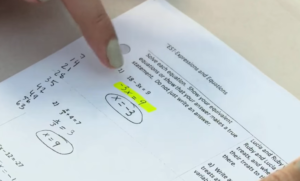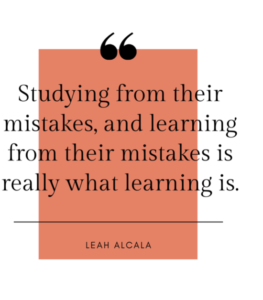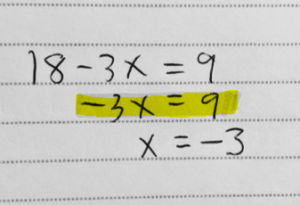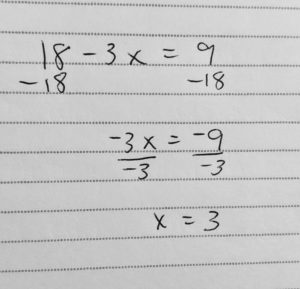Parent Pedagogy 101 is a multi-part Insights series that focuses on strategies that serve as the foundation for great learning, whether at home or at school. In this series we discuss methods for questioning, normalizing mistakes, incorporating wait time, and keeping it positive, even when you don’t know the answer. Our hope is this can be useful for parents directly or for educators and school and district leaders to share out themselves, in order to help families navigate the barrage of resources and assignments coming their way.
Part 2 in our series: HIGHLIGHT MISTAKES, LITERALLY. GO FIND A HIGHLIGHTER!
The third period bell rang and my high school students began putting homework questions on the board, passing back papers, and checking their homework answers. Out of the corner of my eye I saw a student crumple his graded test into a ball and throw it into his backpack. I immediately turned to walk toward him, but stopped. I began to ask myself: Why did he throw his test into his backpack? Why hadn’t he looked at the problems he had missed? Didn’t he want to know how to fix his mistakes? This is when I realized it wasn’t any mistake he had made that was the issue; it was a mistake I had made.
My students had no qualms about asking questions when learning new material, but I had not yet developed a culture that made assessments part of the process instead of the end. Mistakes did not need to be a confidence-breaker or the final say on what knowledge you had or had not gained. It was time to reframe what making a mistake meant.

While researching how to embed this mindset into my classroom culture, I came across Highlighting Mistakes – A Grading Strategy, a video by middle school teacher Leah Alcala. In the video, Ms. Alcala shares her highlighting strategy and how it normalized the process of making mistakes. Her students used to look at their grade and decide whether they were good at math or not and then never look at that test or assignment again. Now, her students have the opportunity to wrestle with math first and think about the grade second. This was exactly what I was looking to implement with my students.
GETTING STARTED:
Whether it be in the classroom or learning at home, your child will make mistakes, and an adult’s reaction to these mistakes can either enhance the learning and build confidence or create a negative experience. I will never forget accidentally using powdered sugar instead of flour to bake my first batch of cookies. My mom could have gotten upset about the gooey mess all over the oven, but instead we laughed, cleaned the oven, and decided to label the jars of dry ingredients. Her reaction helped me to understand that what I learned from the mistake was more important than the mistake itself.
In last week’s Insight, Don’t Answer Questions, Ask Them, we discussed how asking questions can guide your child through learning without telling them the answers. This week’s strategy builds on that concept by highlighting mistakes to allow your child the opportunity to take a second look without judgement. A big red X on a missed question isn’t the only way to convey a mistake. So before you start marking up your child’s assignments, grab the highlighter instead of the pen and begin searching for mistakes.
HOW IT WORKS:
When reviewing your child’s classwork and homework, identify where something went wrong or needs additional attention by highlighting the problem number or where the mistake occurred. Then give your child the opportunity to revisit anything that is highlighted. Taking a  second look by themselves might be all they need to correct the mistake. If not, ask a few why, how, and what questions to help guide your child to a correct or more thorough answer.
second look by themselves might be all they need to correct the mistake. If not, ask a few why, how, and what questions to help guide your child to a correct or more thorough answer.
In this example from Ms. Alcala’s classroom, she highlighted where the student made a mistake: -3x=9. The work isn’t entirely wrong, but a mistake was made. Let’s take a look at how this might be addressed at home:
|
ORIGINAL WORK:
|
Parent: What happened here?
Child: I don’t know what I did wrong. Parent: Ok. What did you do to get to this step? Child: I don’t know. Parent: Well, I noticed that the 18 is gone. What happened to it? Child: Umm, oh I remember! I subtracted 18 from both sides. Parent: Great! I noticed you did this in your head the first time. Can you show me that step? Can you write out the work? Child: Yep… I see now! It’s negative 9, not 9. Parent: You got it! Let’s finish it. Child: Divide by negative 3. So now I get x equals 3. |
Completing work independently is important, but your child may need a little extra support in the beginning. Try utilizing the questioning technique from last week’s insight, Don’t Answer Questions, Ask Them, to support your child.
SEE IT IN ACTION:
Here is a short video of Ms. Alcala’s strategy of highlighting mistakes, Highlighting Mistakes – A Grading Strategy. In this video you will see how seventh grade students:
- Work to fix their own highlighted mistakes.
- Verbally explain their mistakes and how they corrected them.
- Work together to fix Ms. Alcala’s “Favorite Mistakes” – common mistakes made by students.
- Have shifted their mindset about learning from only being about the grade to now include a deeper understanding of the content as well.
One important lesson to note is that the number of mistakes or highlighted areas does not indicate a specific grade or how much your child knows. Your child may be making the same mistake throughout an assignment or may be making different mistakes each time. By highlighting and taking a second look at the mistakes, you can determine if they need extra content support, or if they will be ready to move on after a second look.
Making this quick switch from a pen to a highlighter can drastically change the mindset your child takes toward making mistakes and learning. The change in my own students didn’t happen overnight, but it did happen. The very same student who crumpled up his test became the first student to dive into corrections when tests were passed back. He even developed the mindset that if he didn’t make any mistakes, then I, as his teacher, hadn’t made the work hard enough.
During this time of distance learning plans and virtual lessons, it is understandably challenging for parents to balance the competing demands of caring for children, teaching them, and trying to complete a bit of remote work. Know that you don’t have to be perfect; embracing your own mistakes or challenges with a positive mindset is a useful lesson for your child to see, too. Hopefully these strategies can help make those “What do I do now?!” moments a little less frequent and a little easier to get through together.
Join us next week for The Power of Wait Time.
Kelly Zunkiewicz is a national award-winning teacher with a decade of teaching experience. She has insight into the minds of educators and students and understands what makes great teaching happen.


